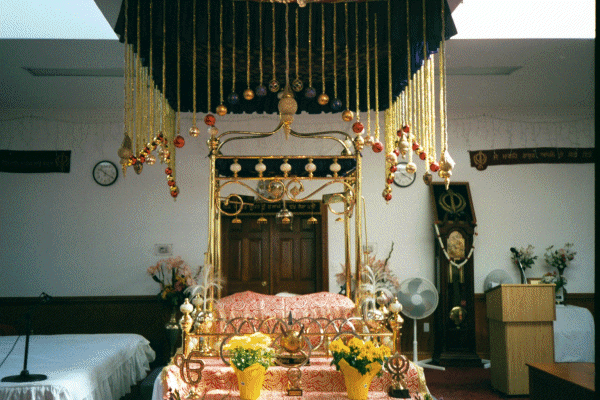|
Teo and I went to the Gurdwara Sahib, the Sikh temple on Ox Road, not far from the Durga Temple in Fairfax. It was approximately 1030 on a Friday morning and the place was deserted. We parked our cars out back, put our shoes in the shoe boxes and noticed that there were a pair already there. Well the doors were open, the lights were on, but no one was home. We searched for life downstairs, then upstairs... it was empty.
Well we decided that we would have to come back for another visit when there would be a congregation of some sorts, went to get our shoes. Before departing we picked up copies of the free newspapers. One was in English, the other was not. I read the English paper and found that many of the articles were referring to the recent incidents regarding the attack that killed 50 Hindus in India and the retaliatory attacks against Muslims. * * * * * We visited the Gurdwara Sahib again today, and this time it was full of life and activity. As soon as I arrived, I noticed how happy and pleasant everyone was. I saw families, children, couples, even a few elderly couples, and of course many individuals. I picked up strong community related vibes from everyone. And they had all come out to worship together. I picked up a couple of flyers and saw lots of people chatting and eating in the main room downstairs. Then I went upstairs. At approximately 3 stairs from the top, a gentleman stopped me and informed me that I must cover my head before entering. My first thoughts were. "Oh my goodness, I don't have anything to cover my head.... now I can't get in... I am in trouble", but the gentleman told me that I could find plenty of extra scarves on the table in the foyer downstairs.. and I did. I covered my head, proceeded back upstairs and asked if the picture on the wall was of Guru Nanak. The gentleman's eyes light up and he replied that it was, he pointed to another picture on my left and I said "That's the Golden Temple." He must have been impressed, because he started asking me questions. He offered to show me around a little later, but for now he was collecting donations. He went downstairs and I continued to admire the Golden Temple. Soon, I heard him calling to get someone's attention. I thought that I'd done something wrong again, but it was not me this time... it was Teo. He was trying to stop her before she entered the worship hall without a head covering. We got her all covered up and asked about the function of the head scarves. He replied that it was a tradition to cover the hair before entering the worship hall and that we would not have been able to enter an Islamic mosque without a covering, not even the outer hallway. Then we went into the worship hall. We were a bit early, so we looked around and watched the worshippers as they entered. The floor was covered with white sheets, as I'd seen in the Hindu temple in Chantilly. Musicians were at the microphones next to the shrine, singing and playing their instruments. Before entering the hall, most people touched the floor and then touched their forehead, then walked along the path to the shrine of the Guru Granth Sahib. There was a gentleman fanning the Granth, and the worshippers kneeled before the shrine and paid their respects, then chose a seat on the floor, men on one side, women on the other. We sat in the back -luckily we were on the women's side- and bombarded the woman to my right with questions. She was happy to help. She informed us that the touching of the floor and head was a tradition that showed respect to God upon entering his house of worship. She also said that it is their tradition to touch the feet of the elderly as respect and a sort of blessing. The purpose of fanning the Granth was to prevent dust from falling on it and to keep it surrounded by good and fresh air. Males and females are equally allowed to fan the Granth. She informed me that the symbols on the wall that I wondered about was the Sikh symbol for the Gurus. The images of the shield with two crossed swords represented: one sword for cutting down the enemy and evil, the other sword was for defending and protecting religion. We asked about the separation between the men and women, she told us that it was a tradition that would allow each individual to concentrate, meditate and worship, so that their heart will go straight to God. She discussed with us the changes that some of the modern day Sikhs have made: some of the younger men cut their hair and shave their mustache and beards, the bracelet that they must wear at all times is traditionally made of iron, but some people will wear ones made of steel or gold, some younger Sikh Americans do not know the native Punjabi language. These and other changes have been accepted by Sikhs, but most maintain the traditional ways and observe the 5 K's. Soon after we gathered our belongings and retrieved our shoes. It was a wonderful experience and I am glad that I made the trip back. Speaking with the worshippers and watching them worship drove home the Sikh practice of living simple lives and evidence that they do not believe in the rituals and ceremonies like the Hindus. |
| Created by Laura Ellen Shulman |
Last updated: June 2002
|
